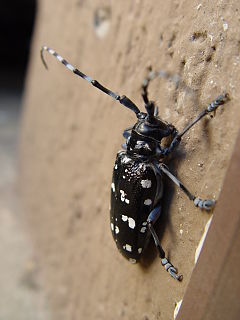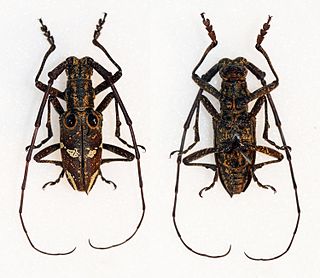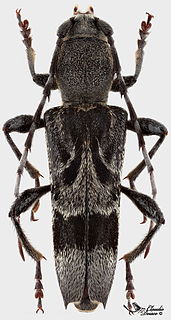Related Research Articles
Bipolar CMOS (BiCMOS) is a semiconductor technology that integrates two semiconductor technologies, those of the bipolar junction transistor and the CMOS logic gate, into a single integrated circuit. In more recent times the bipolar processes have been extended to include high mobility devices using silicon–germanium junctions.

The Asian long-horned beetle, also known as the starry sky, sky beetle, or ALB, is native to eastern China, and Korea. This species has now been accidentally introduced into the United States, where it was first discovered in 1996, as well as Canada, and several countries in Europe, including Austria, France, Germany, Italy and UK. This beetle is believed to have been spread from Asia in solid wood packaging material.

The longhorn beetles (Cerambycidae), also known as long-horned or longicorns, are a large family of beetles, with over 35,000 species described. Most species are characterized by extremely long antennae, which are often as long as or longer than the beetle's body. In various members of the family, however, the antennae are quite short and such species can be difficult to distinguish from related beetle families such as the Chrysomelidae. The scientific name of this beetle family goes back to a figure from Greek mythology: after an argument with nymphs, the shepherd Cerambus was transformed into a large beetle with horns.

Lin is the Mandarin romanization of the Chinese surname written 林. It is also used in Taiwan, Japan, Korea, Singapore, Indonesia, Malaysia, Vietnam, Cambodia.

Coleoxestia is a genus of beetles in the family Cerambycidae, containing the following species:
Phlyctaenodini is a tribe of beetles in the subfamily Cerambycinae that includes the following genera and species.

Dihammaphora is a genus of beetles in the family Cerambycidae, containing the following species:

Anoplophora is a genus of beetles in the longhorn beetle family (Cerambycidae). They are native to Asia. Most are large and colorful and thus are depicted in artwork and sought after by beetle collectors. The genus also includes several notorious pest insects.
Coleoxestia glabripennis is a species of beetle in the family Cerambycidae.
Ancylodonta glabripennis is a species of beetle in the family Cerambycidae.
Dihammaphora glabripennis' is a species of beetle in the family Cerambycidae. It was described by Gounelle in 1911.

Pseudoechthistatus is a genus of longhorn beetles of the subfamily Lamiinae, containing the following species:
Morimopsis glabripennis is a species of beetle in the family Cerambycidae. It was described by Holzschuh in 2003.
Pseudoechthistatus chiangshunani is a species of beetle in the family Cerambycidae. It was described by Bi and Lin in 2016. It is known from China.
Pseudoechthistatus holzschuhi is a species of beetle in the family Cerambycidae. It was described by Bi and Lin in 2016. It is known from Vietnam and China.
Pseudoechthistatus pufujiae is a species of beetle in the family Cerambycidae. It was described by Bi and Lin in 2016. It is known from China.
Pseudoechthistatus sinicus is a species of beetle in the family Cerambycidae. It was described by Bi and Lin in 2016. It is known from China.
Pseudoechthistatus birmanicus is a species of beetle in the family Cerambycidae. It was described by Stephan von Breuning in 1942. It is known from Myanmar.

Pseudoechthistatus obliquefasciatus is a species of beetle in the family Cerambycidae. It was described by Maurice Pic in 1917. It is known from China.

Anaglyptus is a genus of beetles in the family Cerambycidae. The scientific name of the genus was first validly published in 1839 by Mulsant.
References
- ↑ Bi, Wen-Xuan; Lin, Mei-Ying (2016). "A revision of the genus Pseudoechthistatus Pic (Coleoptera, Cerambycidae, Lamiinae, Lamiini)". ZooKeys (604): 77–78. doi: 10.3897/zookeys.604.9049 . PMC 4978020 . PMID 27551207.
- ↑ BioLib.cz - Pseudoechthistatus glabripennis. Retrieved on 8 September 2014.